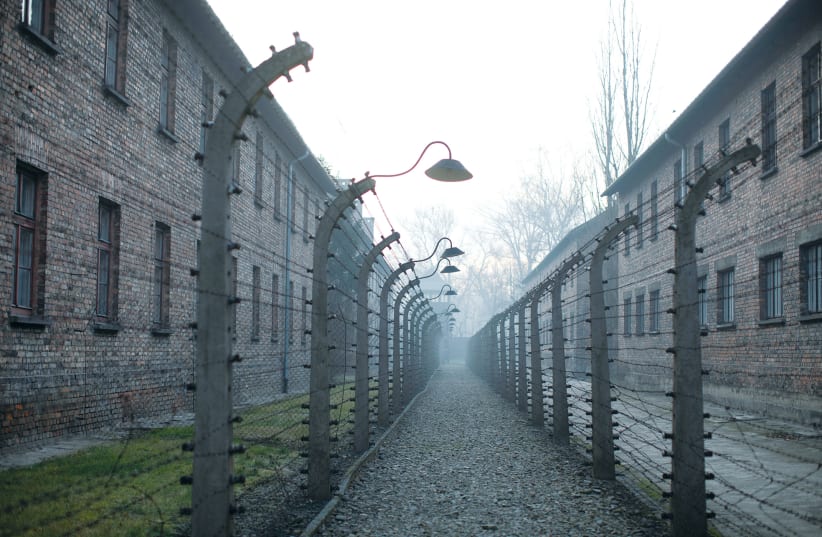When I walked through the gates of Auschwitz-Birkenau in 2019, I had to convince myself I was really at a place where people murdered other humans. Grass grew between the buildings. Hotels were across the street. I tried to imagine how it must have looked when Auschwitz existed as I’d read about it. The image in my mind was in black and white. The Auschwitz of the Holocaust felt less like another time, and more like an alternate reality.
Because of the coronavirus pandemic, attendance at the Auschwitz-Birkenau Memorial and Museum in 2020 was less than a fourth of what it was the year prior. That’s a tragedy. The exhibits’ heartbreaking objects make an overwhelming genocide tangible. There are pots and pans people used. There are the shoes they wore, in child size and adult. And there are literal parts of who they were: thousands of tons of hair.
As I walked along the glass panes of these exhibits, I was crushed by the individual shoe, pot, or locket of hair, just as I was flattened by the enormity of their amalgamation. In Block 27, curated by Israeli museum Yad Vashem, I cried as projectors aimed at every wall screened films of pre-war Jews going to school, getting married, and dancing.
Auschwitz is powerful. It demands our empathy, sorrow, and indignation. And on the 76th anniversary of its liberation this past January, a broadcast focused on commemorating the over 200,000 children murdered there. But as we reflect on its horrors, we should remember that Auschwitz as synonym and symbol of the Holocaust has serious shortcomings.
The Nazis murdered 1.1 million people at Auschwitz, a million of whom were Jews. Since Auschwitz was also a labor camp – and not just an extermination center – it had around 200,000 survivors. Nobel Peace Prize winner Elie Wiesel and renowned essayist Primo Levi, pivotal figures in cementing the Holocaust in public consciousness, were among them.
Treblinka, on the other hand, whose sole operational function was to kill, had just 67 known survivors. It was not liberated, like Auschwitz, but instead was taken apart in the fall of 1943. The Nazis bulldozed Treblinka and tried to disguise it as an innocuous farmhouse that they built in its stead.
The plan to erase Treblinka from the historical record mostly failed. Today, there is a museum and memorial where the camp once stood. Historians have extensively detailed the crimes the Nazis committed there. And yet only 1% of American millennials and members of Gen Z have heard of Treblinka, compared to 44% for Auschwitz.
There are reasons for this gap in awareness. People survived Auschwitz to share their stories. Physical traces remained, though the Nazis blew up the crematoria in a similar attempt to hide evidence. To take Auschwitz as representative might make us think that survival was a matter of odds, rather than the near-certain prescription for those sent to Treblinka. Or that sites of past atrocities are always visible, rather than camouflaged places we need signage to discern.
Auschwitz can also conjure an image of a faceless bureaucracy, a Nazi institution that streamlined the process of mass murder. But 40% of the Holocaust’s Jewish victims were killed in shootings. And though Einsatzgruppen, or mobile killing squads, were pivotal to Nazi plans, Jews also died at the hands of locals who took initiative. During the summer of 1941, many Catholic Polish residents of a small town, Jedwabne, murdered 1600 of their 1607 Jewish neighbors.
TREATING AUSCHWITZ as symbolic of the Holocaust avoids these thornier issues. It is easy to decry the centralized evil of a concentration camp. It is hard to confront the reality that killing happened everywhere, often by individuals, and that most people were complicit either through cooperation or indifference.
Popular works of Holocaust literature have been produced and interpreted to avoid morally indicting the audience. Before he wrote Night, Elie Wiesel wrote an angrier book in Yiddish. And the World Kept Silent excoriated society for its inaction during the Holocaust. But to find an audience, Wiesel changed the theme to a personal loss of faith. Anne Frank is often known for her declaration that “in spite of everything, I still believe people are really good at heart,” even though she also says: “I simply can’t build up my hopes on a foundation consisting of confusion, misery, and death.”
Seventy-six years later, Auschwitz should challenge us to honor its victims, remember its brutality, and fulfill its moral imperative of resisting hatred. It should also spur us to look beyond the obvious, to those silent places where the ghosts of the past don’t align with the history we think we know.
The writer (@nadavsziv) is a junior at Stanford University majoring in international relations.
